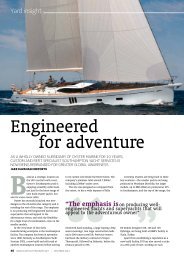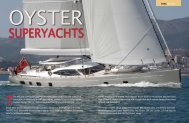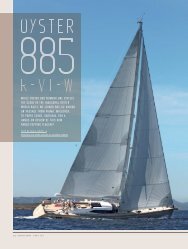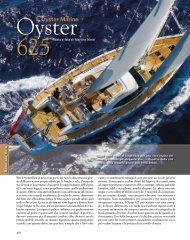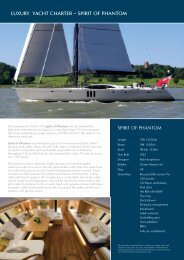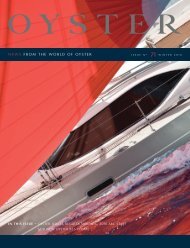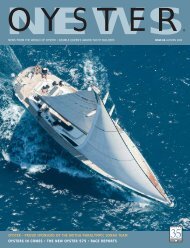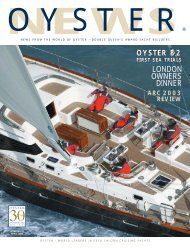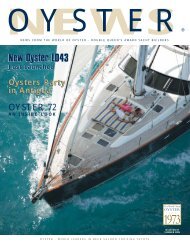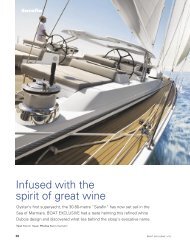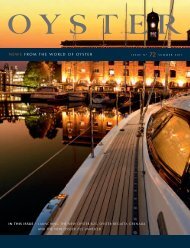Create successful ePaper yourself
Turn your PDF publications into a flip-book with our unique Google optimized e-Paper software.
‘ I don’t choose to be a<br />
competitor at golf, or<br />
sailing, or playing Bridge.<br />
I try to do well, but<br />
winning at those things<br />
isn’t crucial for me.<br />
My competitive instincts<br />
have always been<br />
focused on business. In<br />
business, competitive<br />
success makes a<br />
huge difference<br />
’<br />
22 www.oystermarine.com<br />
Seabees. Jobless at war’s end, Crandall’s<br />
father found employment at Phoenix<br />
Mutual Insurance as a management<br />
trainee. Starting in 1945, he travelled<br />
the country with his family for seven<br />
years learning the insurance trade in<br />
different offices.<br />
It was during that period that Robert<br />
Crandall became the habitual "new kid" at<br />
14 different schools, a tough role. "There<br />
were always fights with other kids to prove<br />
myself," Crandall says. "It was a big pain. I<br />
didn’t enjoy it. But it was unavoidable."<br />
Hard work was also unavoidable. He had a<br />
paper route and worked in grocery stores.<br />
In 1952, the family returned to Rhode<br />
Island. Crandall entered Barrington High<br />
School where one of the first students he<br />
met was Jan Schmults, the girl he would<br />
marry. When he graduated in 1953 Crandall<br />
was voted best student, most ambitious,<br />
and "most affectionate boy" in his class.<br />
After three semesters on scholarship at<br />
William and Mary College, Crandall<br />
transferred to University of Rhode Island to<br />
be closer to Jan. He buffed the cafeteria<br />
floor and did other part time jobs to cover<br />
expenses. After graduating with a degree<br />
in business administration, he and Jan<br />
married. Their honeymoon consisted of the<br />
drive to Ft. Benning, Georgia, where<br />
Crandall did a six-month tour of duty while<br />
Jan worked as a nurse.<br />
After a short stint with an insurance<br />
company, Crandall accepted an Arthur<br />
Young scholarship to the University of<br />
Pennsylvania’s Wharton School of<br />
Business. He managed a radio station at<br />
night. He would have preferred law school,<br />
but he couldn’t afford it.<br />
After Wharton, he joined Eastman Kodak<br />
as a credit representative. When he was<br />
told it would take him 20 years at Kodak<br />
to become a vice president, he left and<br />
joined The Hallmark Card Company where<br />
he was asked to run the computer<br />
programming division. The fact that he<br />
knew little about computers didn’t stop<br />
him. He learned, and the decision turned<br />
out to be pivotal. Three years later he<br />
joined TWA as assistant treasurer in<br />
charge of credit operations. Not long<br />
afterwards he was running data<br />
processing for TWA. He was then<br />
attracted to Bloomingdale’s by an offer of<br />
senior vice president and treasurer, but<br />
soon discovered he didn’t care for<br />
retailing. Finally, in 1973, he landed at<br />
American Airlines as chief financial officer.<br />
The first thing Crandall did at American<br />
was upgrade the airline’s data processing<br />
system. Next he modernised American’s<br />
computerised reservation system (SABRE),<br />
to the point where it was eventually spun<br />
off as a private company serving all<br />
airlines. Two years later as Sr. VP,<br />
marketing, Crandall was faced with the<br />
problem of how to generate revenue from<br />
unsold seats, the bane of any airline’s<br />
economics. Charter companies were luring<br />
customers away with lower fares. So<br />
Crandall invented the Super Saver concept<br />
– large discounts for tickets purchased<br />
well in advance – a plan quickly copied by<br />
other carriers.<br />
When the airline business was stunned by<br />
federal deregulation in 1978, Crandall had<br />
risen to President and CEO. In the face of<br />
deregulation, Wall Street took one look at<br />
American’s long-haul fleet and lack of<br />
hubs and dubbed the airline a loser.<br />
Crandall proved them wrong. His solution<br />
was to build a complex hub-and-spoke<br />
system and to emphasise technology.<br />
During Crandall’s tenure, American<br />
maintained one of the largest staffs of<br />
operations research professionals of any<br />
company in the country. The cumulative<br />
effect of those and other decisions<br />
resulted in the lower fares and better<br />
schedules economists had thought<br />
deregulation would produce and better<br />
results for American Airlines.<br />
"Management," Crandall says, "is a twopart<br />
proposition. First is the creative vision:<br />
you lay out what you think the future is.<br />
Conceptualisation. Part two is execution,<br />
making it happen. You have to adapt, but<br />
everyone adapts. You also have to have<br />
accurate vision. What happened at Braniff<br />
is a case in point. American has often<br />
been accused of putting Braniff out of<br />
business, but that’s not what happened.<br />
When deregulation came along, Braniff<br />
already had a small hub system in Dallas<br />
that was working well for them. But their<br />
top management determined that




